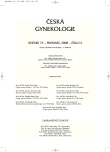Validity of Hysteroscopy in Clinical Setting: Single Centre Analysis of 605 Consecutive Hysteroscopies
Authors:
J. Višňovský 1; P. Zubor 1; S. Galo 1; D. Klobusiaková 1; R. Fiolka 1; K. Kajo 2
Authors‘ workplace:
Gynekologicko-pôrodnícka klinika JLF UK a MFN
1; Ústav patologickej anatómie JLF UK a MFN, Martin
2
Published in:
Ceska Gynekol 2008; 73(6): 365-369
Overview
Objective:
Hysteroscopy represent standard diagnostic and therapeutic method in the treatment of endometrial pathology, where patient selection for this procedure depends in majority on preoperative uterine ultrasound scan. Hysteroscopy can be used for removal of polyps or myomas, endometrial tumor resection, synechiolysis, sterilisation or removal of remnants from pregnancy. Hysteroscopic surgery can be also an option for patients who wish to preserve the uterus for the treatment of recurrent bleeding. We aimed to evaluate the validity, complication rate and accuracy of hysteroscopy in correlation with preoperative ultrasound and postoperative histopathological findings.
Setting:
Department of Gynecology and Obstetrics, Jessenius Medical Faculty, Commenius University, Martin, Slovak Republic.
Subject and method:
Retrospective analysis of hysteroscopies for period of 24 months.
Results:
During study period a total of 605 hysteroscopies were performed. In three (0.5%) cases we did not acquired sufficient bioptic material required for histopathological diagnosis, thus only 602 cases were included in the final analyses. The most frequent indication for hysteroscopy was history of postmenopausal bleeding (35.88%), followed by endometrial polyp (30.9%), hyperplasia (28.24%), cervical polyp (2.32%), corpus alienum in the uterus (1.66%) and fertility disorders (1%). Multifactorial analysis of hysteroscopy, ultrasound and histopathological findings revealed 69.41% sensitivity rate for ultrasound finding of endometrial hyperplasia, 48.16% sensitivity rate for submucous myoma and 81.72% sensitivity for endometrial polyp. The last group of patients showed the highest correlation rate (r) = 0.41, p<0.01. The false pozitivity of preoperative ultrasound was 30.59%, 51.84% and 18.28% for mentioned groups, respectively. The association between hysteroscopic and histopathological results showed a 97.1% agreement in patients with endometrial polyp and 89.3% agreement for cases with endometrial hyperplasia (p<0.05). In 66.45% was hysteroscopy associated with biopsy or curretage. The causally surgery (tumor or endometrium ablation, myoma or septum resection) was performed in 27.9% and in 5.65% others types of intrauterine hysteroscopic sugery were done. Out of all surgical procedures polyp ablation represented 63.2%, resection of submucous fibroids 21.2%, endometrial resection or ablation 7.2% and 8.4% others procedures. In studied population we diagnosed 18 (3%) cases of endometrial carcinoma (13 cases associated with hyperplasia, 5 with polyp). Complication rate was 0.66%. Diagnostic hysteroscopic procedures were associated with a significantly lower complication rate (0.19%) than operative procedures (0.82%; p<0.05). The most frequent surgical complication was perforation of the uterine cavity (three cases 0.50%), followed by fluid overload syndrome (0.17%).
Conclusion:
Hysteroscopy is safe diagnostic and operative method with high sensitivity, particularly for endometrial polyps. The validity of sonography in case of hyperplasia prior surgery could be improved by control uterine ultrasound scan reflecting cycle phase one-two days before surgery.
Key words:
hysteroscopy, complications, accuracy.
Sources
1. Clark, TJ., Voit, D., Gupta, JK., et al. Accuracy of hysteroscopy in the diagnosis of endometrial cancer and hyperplasia: a systematic quantitative review. JAMA, 2002, 288, p. 1610-1621.
2. Daniell, JF., Kurtz, BR., Ke, RW. Hysteroscopic endometrial ablation using the rollerball electrode. Obstet Gynecol, 1992, 80, p. 329-332.
3. Emanuel, MH., Verdel, MJC., Stas, H., et al. Gynaecological Endoscopy. Vol. 4. United Kingdom, 1995. An audit of true prevalence of intra-uterine pathology: The hysteroscopical findings controlled for patient selection in 1202 patients with abnormal uterine bleeding. 1995, p. 237–241.
4. Galo, S., Zubor, P., Kajo, K., et al. Is diagnostic curettage sufficient prior to endometrial ablation? Case of an early stage endometrial cancer. Ces Gynek, 2005, 70, p. 449-452.
5. Gimpelson, RJ., Rappold, HO. A comparative study between panoramic hysteroscopy with directed biopsies and dilatation and curettage. A review of 276 cases. Am J Obstet Gynecol, 1988, 158, p. 489-492.
6. Jansen, FW., Vredevoogd, CB., van Ulzen, K., et al. Complications of hysteroscopy: a prospective, multicenter study. Obstet Gynecol, 2000, 96, p. 266-270.
7. Karlsson, B., Granberg, S., Wikland, M., et al. Transvaginal ultrasonography of the endometrium in women with postmenopausal bleeding--a Nordic multicenter study. Am J Obstet Gynecol, 1995, 172, p. 1488-1494.
8. Leone, FP., Carsana, L., Lanzani, C., et al. Sonohysterographic endometrial sampling and hysteroscopic endometrial biopsy: a comparative study. Ultrasound Obstet Gynecol, 2007, 29, p. 443-448.
9. Lijmer, JG., Bossuyt, PM., Heisterkamp, SH. Exploring sources of heterogeneity in systematic reviews of diagnostic tests. Stat Med, 2002, 21, p. 1525-1537.
10. Parsons, AK., Lense, JJ. Sonohysterography for endometrial abnormalities: preliminary results. J Clin Ultrasound, 1993, 21, p. 87-95.
11. Paschopoulos, M., Polyzos, NP., Lavasidis, LG., et al. Safety issues of hysteroscopic surgery. Ann N Y Acad Sci, 2006, 1092, p. 229-234.
12. Ribeiro, CT., Rosa-E-Silva, JC., Silva-de-Sá, MF., et al. Hysteroscopy as a standard procedure for assessing endometrial lesions among postmenopausal women. Sao Paulo Med J, 2007, 125, p. 338-342.
13. Sagiv, R., Sadan, O., Boaz, M., et al. A new approach to office hysteroscopy compared with traditional hysteroscopy: a randomized controlled trial. Obstet Gynecol, 2006, 108, p. 387-392.
14. Sutton C. Hysteroscopic surgery. Best Pract Res Clin Obstet Gynaecol, 2006, 20, p. 105-137.
15. van Dongen, H., de Kroon, CD., Jacobi, CE., et al. Diagnostic hysteroscopy in abnormal uterine bleeding: a systematic review and meta-analysis. BJOG, 2007, 114, p. 664-675.
Labels
Paediatric gynaecology Gynaecology and obstetrics Reproduction medicineArticle was published in
Czech Gynaecology

2008 Issue 6
Most read in this issue
- Dilemma of the Results Interpretation of Molecular Genetic Analysis with a Focus on CFTR Gene Mutations in Men with Reproductive Disorders and in Gamete Donors
- The Clinical Significance of Sentinel Lymph Node Micrometastases in Breast Cancer
- Validity of Hysteroscopy in Clinical Setting: Single Centre Analysis of 605 Consecutive Hysteroscopies
- Efficacy and Safety of Solifenacin in Daily Clinical Practice – Clinical Study Phase IV
